NVIDIA GeForce GTX 670 Review Feat. EVGA: Bringing GK104 Down To $400
by Ryan Smith on May 10, 2012 9:00 AM ESTOC: Power, Temperature, & Noise
Our final task is our look at GTX 670’s overclocking capabilities. Based on what we’ve seen thus far with GTX 670, it looks like NVIDIA is binning chips based on functional units rather than clockspeeds. As a result GTX 670 could have quite a bit of overclocking potential, albeit one still limited by the lack of voltage control.
| GeForce 600 Series Overclocking | |||||
| GTX 670 | EVGA GTX 670SC | GTX 680 | |||
| Shipping Core Clock | 915MHz | 967MHz | 1006MHz | ||
| Shipping Max Boost Clock | 1084MHz | 1188MHz | 1110MHz | ||
| Shipping Memory Clock | 6GHz | 6GHz | 6GHz | ||
| Shipping Max Boost Voltage | 1.175v | 1.162v | 1.175v | ||
| Overclock Core Clock | 1065MHz | 1042MHz | 1106MHz | ||
| Overclock Max Boost Clock | 1234MHz | 1263MHz | 1210MHz | ||
| Overclock Memory Clock | 6.9GHz | 6.6GHz | 6.5GHz | ||
| Overclock Max Boost Voltage | 1.175v | 1.162v | 1.175v | ||
Because of the wider gap between base clock and boost clock on the GTX 670 we see that it doesn’t overclock quite as far as GTX 680 from a base clock perspective, but from the perspective of the maximum boost clock we’ve slightly exceeded the GTX 680. Depending on where a game lands against NVIDIA’s power targets this can either mean that an overclocked GTX 670 is faster or slower than an overclocked GTX 680, but at the same time it means that overclocking potential is clearly there.
We’re also seeing another strong memory overclock out of a GK104 card here. GTX 680 only hit 6.5GHz while GTX 690 could hit 7GHz. GTX 670 is only a bit weaker at 6.9GHz, indicating that even with the relatively small PCB that NVIDIA can still exceed the high memory clocks they were shooting for. At the same time however this is a luck of the draw matter.
The EVGA card meanwhile fares both worse and better. Its gap between the base clock and and maximum boost clock is even larger than the reference GTX 670, leading to it having an even lower overclocked base clock but a higher overclocked maximum boost clock. The real limiting factor however is that it couldn’t reach a memory overclock quite as high as the reference GTX 670 – again, luck of the draw – which means it can’t match the overclocked reference GTX 670 as it’s going to be more memory bandwidth starved more often.
Moving on to our performance charts, we’re going to once again start with power, temperature, and noise, before moving on to gaming performance. We’ll be testing our GTX 670 cards at both stock clocks with the maximum power target of 122% (170W) to showcase what is possible at validated clockspeeds with a higher power cap, and a true overclock with a maximum power target along with the largest clock offsets we can achieve.
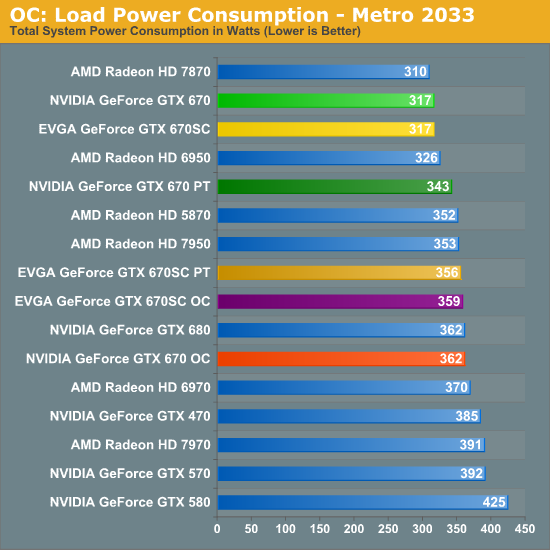
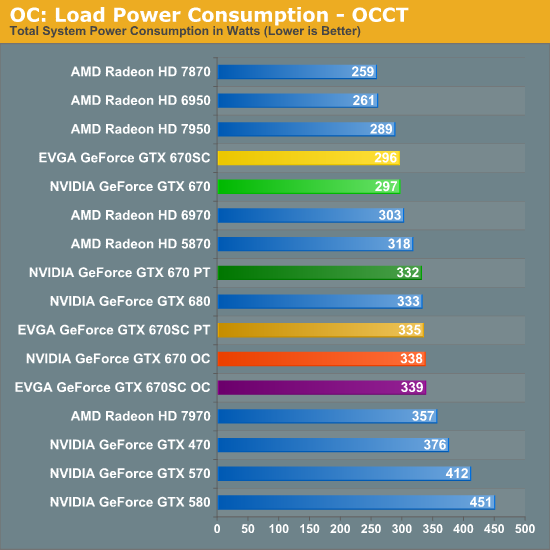
Not surprisingly, since we’re almost always operating within the realm of the power target as opposed to the TDP on the GTX 600 series, our power consumption closely follows our chosen power target. Cranking up the power target on the GTX 670 for example to 170W puts us within 6W of the GTX 680, which itself had a 170W power target in the first place. This is true for both Metro and OCCT, which means power consumption is very predictable when doing any kind of overclocking.
This also means that power consumption is still 18W-30W below the 7970, which in turn means that if these overclocks can close the performance gap, then the GTX 670 still has a power consumption advantage.
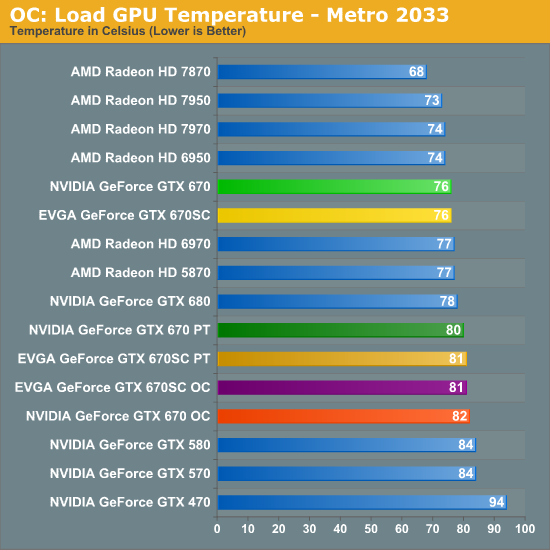
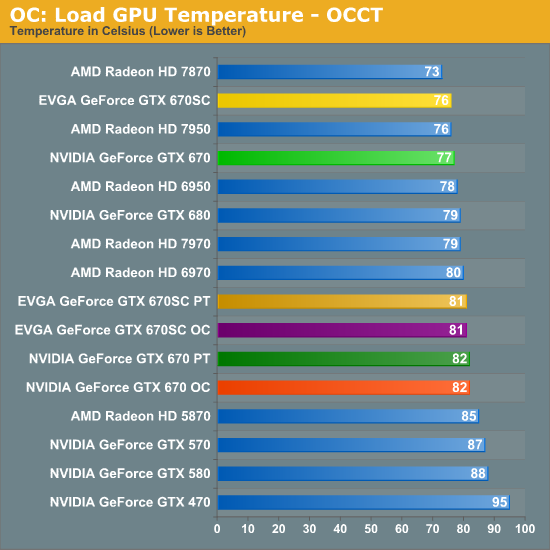
As to be expected, with an increase in power consumption comes an increase in load temperatures. However the fact that we’re only able to increase power consumption by about 30W means the temperature rise is limited to 4-5C, pushing temperatures into the low 80s. This does end up being warmer than the equivalent GTX 680 however due to the 680’s superior heatsink.
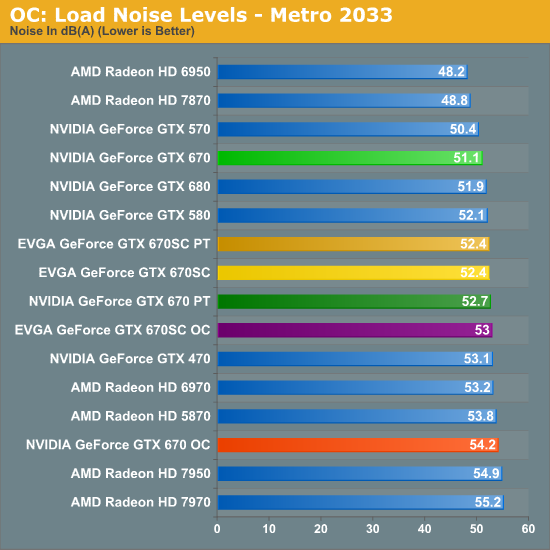

Finally, when it comes to noise we’re also seeing the expected increase, but again it’s rather small. Under Metro the amount of noise from the reference GTX 670 rises by under 3dB when pushing the power target higher on its own, while it rises 3dB when adding in our full overclock. Again the smaller cooler means that the GTX 670’s fan has to work harder here, which means our gaming performance may be able to reach the GTX 680, but our noise is going to slightly exceed it. As a point of reference, in the process we’ll also exceed the GTX 580’s noise levels under Metro. Still, in both OCCT and Metro none of our GTX 670 cards exceed the Radeon HD 7900 series, which means we've managed to increase our performance relative to those cards without breaching the level of noise they generate in the first place.










414 Comments
View All Comments
SlyNine - Sunday, May 13, 2012 - link
The 5800 ultra was pretty bad. the 2900XT was pretty bad to. And god forbit if you actually payed for the 5200ultra.The Geforce 2 ultra was a bad value (even tho I bought one of those).
celestialgrave - Thursday, May 10, 2012 - link
"The only other change you’ll notice is that <b>NVIDIA</b> is using their own high flow bracket in place of NVIDIA’s bracket. The high flow bracket cuts away as much metal as possible, maximizing the area of the vents. Though based on our power and temperature readings, this doesn’t seem to have notably impacted the GTX 670 SC."First Nvidia meant to be EVGA?
Ryan Smith - Thursday, May 10, 2012 - link
One would assume so. Thanks.Lepton87 - Thursday, May 10, 2012 - link
Ever since 6870 launch you had strict policy of no OC cards in launch articles yet you did it again. Where's the consistency?Ryan Smith - Thursday, May 10, 2012 - link
To be clear, our policy is no COMPETING OC cards in a launch article. You guys have specifically indicated that you want us to avoid the FTW scenario. If someone launches a competing card at the same time as another major launch, that card will be in a separate article and judged as such.However we've bundled retail cards into reviews for quite some time; this isn't any kind of change. It allows us to quickly cover semi-custom cards that are similar to the original while not being redundant.
raghu78 - Thursday, May 10, 2012 - link
The HD 6870 review was HD 6870 stock with GTX 460 OC. Now you have 670 and 670 OC cards in this review. I don't see any problems in a HD 7950 OC being pitted against a 670 OC.silverblue - Thursday, May 10, 2012 - link
Yes, but we're talking the 670 vs. overclocked 670s. The 6870 review threw an overclocked 460 into the mix which takes a lot of attention away from the actual card being reviewed.Any overclocked AMD vs. NVIDIA comparisons should be made in a separate article.
RussianSensation - Thursday, May 10, 2012 - link
It's extra data being presented. If you don't want to read it, just ignore it. It doesn't hurt the review in any way. If anything it shows that an overclocked 7950 has NO CHANCE to match an overclocked 670. The direct competitor to the 7950 is therefore superior based on this review. It's not necessary to see HD7950 oced vs. 670 per say given the massive performance lead in games such as BF3, Batman AA, etc. HD7950 no longer makes any sense for $399.Morg. - Thursday, May 10, 2012 - link
TWIMTBP v2.0 : now hidden for more nerdrage and forumwarsRussianSensation - Thursday, May 10, 2012 - link
Well some people here are always too quick to blame fanboys on logical arguments and facts:"With performance that comes awfully close to a fully enabled GK104, the GTX 670 poses a nightmare scenario for AMD. Fresh off a round of price drops, they now have to contend with a card that retails for the same price as a HD 7950 but runs dead even with a HD 7970 in everything except multi monitor resolutions. To add insult to injury, the Radeon cards fight a losing battle in the performance per watt and acoustics categories as well. Free game offer or not, without another $50 to $75 shaved off, we can’t think of a single scenario where a gamer should choose a Tahiti-based card over the GTX 670. "
http://www.hardwarecanucks.com/forum/hardware-canu...